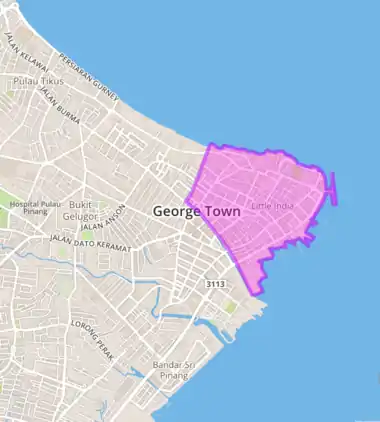Penang High Court
The Penang High Court, founded in 1808, is the birthplace of Malaysia's judiciary system. It is housed inside a Palladian-style building at Light Street, George Town, Penang. To this day, the High Court sits at the top of Penang's hierarchy of courts.
| Penang High Court | |
|---|---|
Mahkamah Tinggi Pulau Pinang (Malay) | |
.jpg.webp) | |
 | |
| General information | |
| Type | High Court |
| Architectural style | Palladian |
| Town or city | George Town, Penang |
| Country | Malaysia |
| Coordinates | 5.42076°N 100.3398°E |
| Construction started | 1901 |
| Inaugurated | 1903 |
| Renovated | 2005 |
| Type | Cultural |
| Criteria | ii, iii, iv |
| Designated | 2008 (32nd session) |
| Reference no. | 1223 |
| Region | Asia-Pacific |
The current courthouse was built in the 1900s to replace the original structure that was built at the same site in 1809. The Penang High Court, then known as the Supreme Court, had been established in 1808 within Fort Cornwallis nearby, the first such court to be set up in the Malay Peninsula.[1] Its establishment also marked the introduction of a modern legal system in Malaya, which would evolve to become the current judiciary of Malaysia.
The Penang High Court has a long pioneering history in Malaysian judiciary. It was here where the first female judge was admitted into the Straits Settlements and Federated Malay States Bars in the 1920s. Malaysia's first Prime Minister, Tunku Abdul Rahman, was also admitted into the Bar in 1974 within the compound of the Penang High Court.
The courthouse was renovated in the 2000s, during which a new wing was added.[2] Across Light Street, another courthouse housing the Magistrates and Sessions Courts was also completed.
History

As Penang Island, then named the Prince of Wales Island, flourished into a strategic entrepôt with a growing immigrant population, Captain Francis Light sought the advice of the Governor-General in India on establishing a judicial authority within the new settlement.[1] In 1807, a Royal Charter of Justice was granted by King George III for the British East India Company authorities in Penang to establish a police force and a Court of Justice.[3]
The Supreme Court of Penang was opened at Fort Cornwallis, George Town on 31 May 1808.[1][3] Sir Edmond Stanley became the first Recorder of the Supreme Court of Penang,[4] and therefore, of all of Malaya. This event marked the birth of Malaysia's judiciary and legal profession.
Sir Stamford Raffles, who later founded Singapore, also served as the first registrar of the Supreme Court. When the Straits Settlements was formed in 1826 by amalgamating Penang, Singapore and Malacca, the jurisdiction of the Supreme Court of Penang was extended to Singapore and Malacca as well. It was only in 1855 when the judicial centre of the Straits Settlements was finally moved to Singapore.[5]
In 1809, the Supreme Court of Penang was shifted a short distance away to its current grounds at Light Street. The original court building was of wooden construction, topped by an attap roof.[6]
.jpg.webp)
The present Palladian-style courthouse, designed by John Henry McCallum, the Surveyor-General of the Straits Settlements, was inaugurated in 1903.[7] Its construction cost $206,678 (Straits dollar). The Palladian architecture is obvious from the courthouse's domed chamber and columns. There were originally statues and emblems on the building as well, although these have since been removed.

Until the end of the 20th century, the Penang High Court was the scene of some of Malaysia's firsts in the legal field.[1] The first pair of Malayan-born siblings to be called into the Bar were Mr. Lim Khye Seng and Mrs. B. H. Oon, both of whom practised law in the Penang High Court. Mrs. Oon also became the first female Asian lawyer to be admitted into the English Bar in 1926, as well as the first female into the Straits Settlements and Federated Malay States Bars in the following year. In 1974, Tunku Abdul Rahman, who had been the first Malaysian Prime Minister until 1970, was also called into the Bar at the Penang High Court.
Among the other famous lawyers who had once served at the Penang High Court are Karpal Singh and Cecil Rajendra.[6]
The courthouse was renovated in 2005 and a new 3-storey wing was added to the east.[8] Additional courthouses were also built across Light Street; these now house the Magistrates and Sessions Court for the Northeast Penang Island District.[9]
References
- "Brief History - Penang Bar Committee". penangbar.org. Archived from the original on 25 March 2018. Retrieved 17 November 2016.
- "Not looking so majestic now - Nation | The Star Online". www.thestar.com.my. Retrieved 16 May 2017.
- "History of The Malaysian Judiciary | Chief Registrar's Office Federal Court of Malaysia Official Website". www.kehakiman.gov.my. Retrieved 17 November 2016.
- Recorder was a title given to some judges at the time: "Singapore Legal History: The Development of the Court System".
- "Judicial History". Supreme Court of Singapore.
- Hockton, Keith (2012). Penang: An Inside Guide to Its Historic Homes, Buildings, Monuments and Parks. Kuala Lumpur: MPH Group Publishing. ISBN 9789674153038.
- Story, Penang's History-My. "Alma mater right smack in the centre of historical George Town - Community | The Star Online". Retrieved 16 May 2017.
- "Not looking so majestic now - Nation | The Star Online". www.thestar.com.my. Retrieved 16 May 2017.
- "Court Directory - Penang Bar Committee". penangbar.org. Archived from the original on 3 December 2016. Retrieved 17 November 2016.